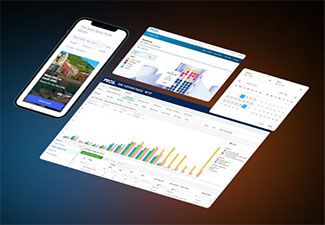CFOs Lower Financial Risk by Leveraging Big Data for Price Improvement
January 10, 2013-
By Craig Zawada
According to PROS Senior Vice President Craig Zawada, only a small percentage of CFO innovators have embrace one of the most powerful weapons available to them: pricing optimization software.
While CFOs can turn to a variety of technologies to address their business and finance challenges, a relatively small percentage of innovators have embraced one of the most powerful weapons available to them: pricing optimization software.
A recent study revealed that the need to plan for and adapt to competitive price pressures is one of the top three concerns among CFOs. But while CFOs invest in tools and technologies such as sophisticated customer relationship management (CRM) and enterprise resource planning (ERP) systems to address other priorities, most are at risk when it comes to pricing, with very little real-time visibility into how pricing decisions affect margins. Consider these examples of how the lack of a pricing strategy can negatively impact business:
- A large semiconductor company made off-invoice adjustments on 10,000 different transactions in one year.
- An automotive parts company discovered a large percentage of its $78 million in freight charges was not passed on to customers, despite a policy in place to do so.
- A major equipment rental company realized it was making 2.5 million pricing decisions annually, with little insight into the effectiveness of these decisions.
The ability of CFOs to maintain margins is dependent on their visibility into pricing decisions, and the ability to react in real time. Pricing optimization software can lower this risk, providing visibility into the impact of pricing decisions and arming CFOs with real-time intelligence. In fact, according to consulting firm McKinsey & Company, as little as a 1 percent improvement in price can yield more than 8 percent increase in profit for the average S&P 1000 company.
But leveraging technology to make sound pricing decisions is dependent on “big data.” And more and more companies are leveraging volume, variety, and velocity of this data that has been created by advances in computing power and data storage.
Many companies have made progress in pricing without big data until now — from instituting pricing rules to creating pricing organizations and attaining high-level visibility on pricing performance. They have made significant investments in ERP, CRM, and other salesforce automation systems to manage their businesses more efficiently. Yet, few have turned pricing into a true competitive advantage by leveraging the real big data that moves far beyond traditional transaction data to include customers, products, costs, contracts, rebates, competitors, sales pipelines, inventories, and more.
Like never before, big data allows companies to make smarter business and sales decisions and insights into willingness-to-pay. Based on advanced analysis of price and sales data, it enables companies to:
- Analyze a large number of price points and permutations that derive data-driven pricing recommendations, specifically targeted toward individual customers.
- Employ unbiased data science decision-making for every product, customer, and micro-market.
- Provide a data-driven approach to members of the sales team, which enables them to negotiate with confidence as they drive price, sales volume, and margin uplift, with price consistency and price rationality in complex environments that include multiple channels, millions of products, and thousands of customers.
Take the example of an engineering services company. This organization had few pricing processes to help salespeople profitably quote business. Company analysts determined minimum prices using strategic factors they thought were important; however, by applying scientific analysis to contracts, they identified certain types of engineering contracts that could be won even at higher pricing levels. By applying statistics to a wide range of factors, and combining internal sales transactions with external data sources, the company was able to predict willingness-to-pay with precision — and the results were surprising. While some of their strategic factors were statistically validated, many of them did not describe the underlying market dynamics. Yet other factors that were not previously considered turned out to be important price drivers.
Many companies operate this same way. They have taken tactical measures to find and either fix or avoid the extremely low- or negative-profit customers. Few have applied pricing science to identify average-profit customers that could do better when comparing them with other like customers.
Operating at the speed of business
CFOs need immediate access to up-to-date information to respond to volatility in the economy. Pricing factors, and competition. That means pricing must operate in real time to accommodate today’s business complexities.
Take an electrical distribution company with three distribution channels, more than 10,000 products, and thousands of customers. Considering no other variables, at any given point in time there will be millions of sales scenarios. Add in the ongoing complexity of new competitive prices, changes in sales volumes, and new inventory or supply positions, and you can see that companies will miss significant opportunities by applying simple rules of thumb or judgment.
Pricing optimization tools that leverage big data adapt this new knowledge, improve models, and produce updated recommendations to ensure all of the relevant market information is brought to bear for each deal. By using this data, the distribution company was able to increase margins by 160 basis points, even in a very tough economic environment.
Mapping product ‘DNA’
While many companies do a good job of making list-price adjustments based on category-level analysis of pricing opportunities, they struggle with gaining deep visibility into key differences among individual products. However, by applying advanced pricing analysis, companies are able to set list prices for individual products based on a sophisticated analysis of each product’s pricing history, as well as comparisons with other products in similar categories. These tools analyze the amount of discounting on the product, the price spread, the typical share of wallet or invoice the product represents in customer purchases, competitive price trends, and availability to estimate the product’s price elasticity. This insight enables companies to quickly and easily identify underpriced products and calculate the trade-off of margin to sales for specific list prices.
A construction equipment company used to annually adjust its prices at a product-category level. All hydraulic fittings would get the same price increase in a given year. However, they were missing the unique characteristics of each stock-keeping unit (SKU) number within the hydraulics category. Some of the fittings were low-volume and difficult-to-find alternatives, whereas others were easily replaceable with off-the-shelf parts at a local supplier. In addition, some were already much higher-priced than those of competitors, and others still had room for increases while remaining below competitive alternatives.
As a result, the company was under- and over-pricing many of its hydraulic fittings. By analyzing its big data, the company achieved a granular level of analysis that helped the organization overcome the problems of one-size-fits-all pricing and grow margins by more than 250 basis points.
Driving performance
Some companies now have hundreds or even thousands of people involved in making pricing decisions. The result is an explosion of complexity as pricing involves more people in highly complicated negotiations with buyers juggling myriad discounts and promotions.
Yet pricing decision-makers often receive no “grade” on how they perform, because current price or margin measures are too generic and don’t take into account a salesperson’s unique customer and product mix. While one sales rep may appear to be a top achiever, he may well be selling large volumes of products at a loss. By contrast, another rep may sell lower volumes, but at prices that reap far better margins.
By leveraging big data and incorporating pricing best practices, companies are able to create true apples-to-apples comparisons on how salespeople are pricing and performing. The result is a much clearer assessment of an individual’s contributions to improving the profit performance of their company.
In today’s highly volatile and competitive business world, in order to improve their financial outlook and compete and win in their markets, organizations must understand how to leverage big data with advanced pricing science to turn a tremendous, yet often hidden asset into real pricing power and sales effectiveness
Craig Zawada is senior vice president of PROS Inc. (NYSE: PRO) in Houston. He previously spent more than 12 years as a partner with McKinsey & Company.





